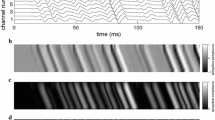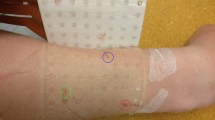Abstract
The paper presents a new approach for simultaneous estimation of muscle fibre conduction velocity (MFCV) and muscle fibre orientation (MFO) for motor units (MUs) in two-dimensional (2D) multichannel surface electromyography recordings. This is an important tool for detecting changes and abnormalities in muscle function and structure. In addition, simultaneous estimation of MFO and MFCV avoids the necessity of manual electrode alignment. The proposed method detected propagating MU action potentials (MUAPs) in a running time window as moving components in amplitude maps. Thereafter, estimations were obtained by fitting a three-dimensional function to these maps. The performance was evaluated using synthetic MU signals at 10 dB SNR and authentic biceps brachii measurements. Results demonstrated MFCV and MFO estimates with standard deviations of less than 0.05 m s−1 and 1° for simulated signals, and less than 0.2 m s−1 and 4° for experimental data. However, standard deviations as low as 0.12 m s−1 and 1.6° from real signals were demonstrated. It was concluded that the method performs as well as, or better than, linear array multichannel methods when individual propagating MUAPs can be identified, even if electrodes are not aligned with fibre direction.
Similar content being viewed by others
References
Andreassen, S., andArendt-Nielsen, L. (1987): ‘Muscle fibre conduction velocity in motor units of the human anterior tibialis muscle: a new size principle’,Physiol.,391, pp. 561–571
Barrodale, J. (1968): ‘L1 approximation and the analysis of data’,Appl. Stat.,17, pp. 51–57
Bellman, R. E. andDreyfus, S. E. (1962): ‘Applied dynamic programming’ (Princeton University Press, 1962)
Blijham, P. J., Van Engelen, B. G. M., andZwarts, M. J. (2002): ‘Correlation between fiber conduction velocity and fiber diameterin vivo’,Clin. Neurophysiol.,113, p. S39
Blijham, P. J., Hengstman, G. J., Ter Laak, H. J., Van Engelen, B. G., andZwarts, M. J. (2004): ‘Muscle-fiber conduction velocity and electromyography as diagnostic tools in patients with suspected inflammatory myopathy: a prospective study’,Muscle Nerve,29, pp. 46–50
Cruz Martinez, A., andLopez Terradas, J. M. (1990): ‘Conduction velocity along muscle fibersin situ in Duchenne muscular dystrophy’,Arch. Phys. Med. Rehabil.,71, pp. 558–561
Edgeworth, F. Y. (1888): ‘On a new method of reducing observations relating to several quantiles’,Phil. Mag. (5th Ser.),25, pp. 184–191
Farina, D., andMerletti, R. (2000): ‘Comparison of algorithms for estimation of EMG variables during voluntary isometric contractions’,J. Electromyogr. Kinesiol.,10, pp. 337–349
Farina, D., andMerletti, R. (2001): ‘A novel approach for precise simulation of the EMG signal detected by surface electrodes’,IEEE Trans. Biomed. Eng.,48, pp. 637–646
Farina, D., Muhammad, W., Fortunato, E., Meste, O., Merletti, R., andRix, H. (2001): ‘Estimation of single motor unit conduction velocity from surface electromyogram signals detected with linear electrode arrays’,Med. Biol. Eng. Comput.,39, pp. 225–236
Farina, D., Zagari, D., Gazzoni, M., andMerletti, R. (2004): ‘Reproducibility of muscle-fiber conduction velocity estimates using multichannel surface EMG techniques’,Muscle Nerve,29, pp. 282–291
Gydikov, A., Gerilovski, L., Radicheva, N., andTroyanova, N. (1986): ‘Influence of muscle fiber end geometry on the extracellular potentials’,Biol. Cybern.,54, pp. 1–8
Hägg, G. M., andGloria, R. (1994): ‘Surface EMG muscular conduction velocity measurement system implemented on a standard personal computer without A/D convertor’,Med. Biol. Eng. Comput.,32, pp. 691–694
Hakansson, C. H. (1956): ‘Conduction velocity and amplitude of the action potential as related to circumference in the isolated fiber of frog muscle’,Acta Physiol. Scand.,37, pp. 14–34
Hogrel, J. Y., andDuchêne, J. (2002): ‘Motor unit conduction velocity distribution estimation: Assessment of two short-term processing methods’,Med. Biol. Eng. Comput.,40, pp. 253–259
Houtman, C. J., Stegeman, D. F., van Dijk, J. P., andZwarts, M. J. (2003): ‘Changes in muscle fiber conduction velocity indicate recruitment of distinct motor unit populations’,J. Appl. Physiol.,95, pp. 1045–1054
Lynn, P. A. (1979): ‘Direct on-line estimation of muscle fiber conduction velocity by surface electromyography’,IEEE Trans. Biomed. Eng.,26, pp. 564–571
Merletti, R., Farina, D., andGazzoni, M. (2003): ‘The linear electrode array: A useful tool with many applications,J. Electromyogr. Kinesiol.,13, pp. 37–47
Naumann, M., andReiners, K. (1996): ‘Diagnostic value ofin situ muscle fiber conduction velocity measurements in myopathies’,Acta Neurol. Scand.,93, pp. 193–197
Narici, M. V., Binzoni, T., Hiltbrand, E., Fasel, J., Terrier, F., andCerretelli, P. (1996): ‘In vivo human gastrocnemius architecture with changing joint angle at rest and during graded isometric contraction’,J. Physiol.,496, pp. 287–297
Rosenfalck, P. (1969): ‘Intra- and extracellular potential fields of active nerve and muscle fibers. A physico-mathematical analysis of different models’,Acta Physiol. Scand., suppl.321, pp. 1–49
Roy, S. H., De Luca, C. J., andSchneider, J. (1986): ‘Effects of electrode location on myoelectric conduction velocity and median frequency estimates’,J. Appl. Physiol.,61, pp. 1510–1517
Sadoyama, T., Masuda, T., andKatsuta, S. (1988): ‘Fibre conduction velocity and fibre composition in human vastus lateralis’,Eur. J. Appl. Physiol. Occup. Physiol.,57, pp. 767–771
Sakamoto, K., andMito, K. (2000): ‘Muscle fiber conduction velocity during isometric contraction and the recovery period’,Electromyogr. Clin. Neurophysiol.,40, pp. 151–161
Schillings, M. L., Hoefsloot, W., Stegeman, D. F., andZwarts, M. J. (2003): ‘Relative contributions of central and peripheral factors to fatigue during a maximal sustained effort’,Eur. J. Appl. Physiol.,90, pp. 562–568
Schlosser, E. J. (1973): ‘An iterative technique for absolute deviations curve fitting’,J. Am. Stat. Assoc.,68, pp. 857–859
Schulte, E., Farina, D., Rau, G., Merletti, R., andDisselhorst-Klug, C. (2003): ‘Single motor unit analysis from spatially filtered surface electromyogram signals. Part 2: Conduction velocity estimation’,Med. Biol. Eng. Comput.,41, pp. 338–345
Troni, W., Cantello, R., andRainero, I. (1983): ‘Conduction velocity along human muscle fibersin situ’,Neurology,33, pp. 1453–1459
Udupa, J. K., Samarasekera, S., andBarrett, W. A. (1992): ‘Boundary detection via dynamic programming’,Vis. Biomed. Comput., Proc. SPIE,1808, pp. 33–39
van der Hoeven, J. H., van der Weerden, T. W., andZwarts, M. J. (1993): ‘Long-lasting supernormal conduction velocity after sustained maximal isometric contraction in human muscle’,Muscle Nerve,16, pp. 312–320
Author information
Authors and Affiliations
Rights and permissions
About this article
Cite this article
Grönlund, C., Östlund, N., Roeleveld, K. et al. Simultaneous estimation of muscle fibre conduction velocity and muscle fibre orientation using 2D multichannel surface electromyogram. Med. Biol. Eng. Comput. 43, 63–70 (2005). https://doi.org/10.1007/BF02345124
Received:
Accepted:
Issue Date:
DOI: https://doi.org/10.1007/BF02345124




